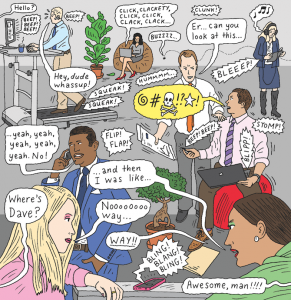 Today, hearing that someone’s office is at a shared workspace is not that strange.
Today, hearing that someone’s office is at a shared workspace is not that strange.
These new collaborative environments, called shared workspaces or coworking offices, actually take many forms and are used in many different work environments.
Some are used virtually, while others are actual physical spaces. In some forms, more than one person utilizes the shared workspace at a time, while another option is a space shared by many people at different times.
Hearing why so many business people are now moving out of shared workspaces and back into their own office space is not surprising either. So what is going on in the shared workspace that is driving business people away?
If you listen closely to the reason business people are giving for leaving shared workspaces you will hear one of 3 problems these coworking facilities need to Deal with.
Here are the 3 problems with Shared Workspaces.
 PROBLEM 1: Unnecessary Noise
PROBLEM 1: Unnecessary Noise
Working in a Shared Workspace is like working in a train station. There is always a lot of coming and going of people. Lots of impromptu gatherings in the open area called the lobby.
It does not take a lot of people to make a lot of noise in a workspace that features warehouse-type wide-open spaces with high open ceilings and unfashionable concrete floors. With the bare walls and hard surfaces, there is nothing to absorb the noise so the voice of someone talking on their phone in one office space bounces around the entire workspace like a conductor calling off train arrivals.
Then, when there is an event held during the day that is intended to benefit a few of the tenants of the facility the noise level becomes overwhelming for the tenants who have other resources for marketing their business.
This means the shared workspaces that covet the industrial factory look are naturally going to be noisy.
SOLUTION 1:
Shared workspaces will have to invest in soundproofing and noise absorption. Placing Noise cancelers just will not work with concrete or hardwood floors.
Things like sound buffer panels hanging from the ceiling and art on the wall are a must.
 PROBLEM 2: Conflicts of Interests
PROBLEM 2: Conflicts of Interests
Since very few shared workspaces do any type of screening or limiting of the number the same types of service professionals they allow as tenants (members) they are setting up a very uncomfortable environment. Allowing competitors to do business in a closed network produces a huge conflict of interest.
Hard feelings between the businesses spill over into the conversations they have with fellow tenants who mention they are doing business with the one or the other competing businesses. The aggravation between the competing businesses heightens when the landlord chooses to use one of the business’ services over using the other located within feet from the landlord’s office.
Eventually, one of, if not both, competing businesses leave the shared workspace facility and will carry with them a negative attitude towards the shared workspace. Over time, these shared workspaces will find it hard to keep their facilities filled with viable business owners.
SOLUTION 2:
Shared workspaces have to screen who they allow to lease space or become a member of their community.
A selection process has to be developed as a policy they follow. This policy of allowing only one business per industry to be a tenant will strengthen the shared workspace’s marketing. Consumer reaction would improve knowing that if they are the first industry to lease space they would not have to worry their competitor is going to move in next door.
 PROBLEM :3 Lack of Professional Atmosphere
PROBLEM :3 Lack of Professional Atmosphere
Shared workspace, or Coworking Space as it was called a few years ago, has always had a connotation of being only for the freelancer free-spirited individuals who look to find work that would allow them to maintain an extra casual lifestyle. In other words, an extra casual coworking space would be a place where you could come to work in your pajamas and still be considered casually dressed.
There is a tremendous need for shared workspace for people who are ultra concerned with their professional image. Actually, everyone should be concerned with how others see them since most everyone is a consumer. 83% of consumers say how a business owner dresses determine how much business they will do with them.
Having others around you who do not hold the same high standard towards how consumers see them will hurt how consumers see you.
SOLUTION 3:
Outside of starting your own Shared Workspace that screens tenants on how they look, the problem will be hard to fix. The solution could be to find your own space and mold it into what will match your image.
If you have a shared workspace and have a goal to last more than a few years then it probably is time to upscale your dress code for your tenants. Creating a more upscale shared workspace environment will draw in the professionally dressed business people who own professionally run businesses.
As the shared workspace gets crowded and the need to portray a more professional image the more the shared workspaces are going to have to get picky on who they allow to lease space or become a member.
Offering elite business networking events and amenities like built-in digital marketing will draw in the businesses who are concerned with their brand’s image. Things are changing in the shared workspace. I hope the ones struggling to fill their space make the change in the right direction.
Let me know how I can help.











